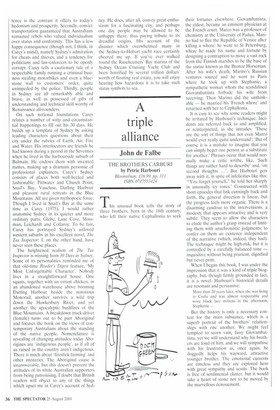A month in the city
Peter Porter
30 DAYS IN SYDNEY by Peter Carey Blooms/Nay, £9.99, pp. 160 ISBN 0747555001 Love or hate Sydney; love and hate Sydney: love to hate Sydney — most Australians fit into the first two of these categories. while Melbournians are chiefly found in the third. But nobody is indifferent to this great city, one of the most mythologised in the modern world. Before writing about it — even when judging
somebody else's view of it — you should declare your interest. My mother came from Sydney and looked on her Brisbane life as exile. I went there each Christmas in the Thirties, and ever since have regarded it as my authentic Babylon. I have lived there only briefly but visited it often. I am a Category Two admirer: arriving in Sydney elates me, listening to its denizens praising their city depresses me. Sydneysiders are inveterate nourishers of their local legends, the majority of which are self-serving. Unfortunately, Peter Carey's short book perpetuates some of the most venial of them, though it gives them a high-gloss magical polish. Perhaps Carey wants to present Sydney to the world as the latest and grandest of super-cities, a sort of compensation for coming himself from respectable Bacchus Marsh.
If you leave the Aboriginals out of the equation, you can explain Sydney's central importance by emphasising that few nations can point to one place and one time as the beginning of their existence, as Australia can, The United States straggled into existence: Australia started on 26 January. 1788 at Botany Bay, shifting soon afterwards to Sydney Cove, modern Circular Quay. The myths began to spring up immediately. Three pieces of special pleading nourish Carey's narrative of a 30 days' drop-in from New York. First, life has always been hard at Port Jackson, something to do with sandstone and poor soil. Happy corollary of this struggle for exis tence is the contrast it offers to today's hedonism and prosperity. Secondly, convict transportation guaranteed that Australians remained rebels who valued individualism over status and conformity. This has a less happy consequence (though not, I think, in Carey's mind), namely Sydney's admiration for cheats and thieves, and a tendency for politicians and law-enforcers to be openly corrupt. Carey tells a cautionary tale of a respectable family running a criminal business stealing motorbikes and even a bluestone wall to customers' order, quite unimpeded by the police. Thirdly, people in Sydney are all remarkably able and brave, as well as possessed of gifts of understanding and technical skill worthy of Renaissance all-rounders.
On such notional foundations Carey relates a number of witty and circumstantial happenings to fill out his 30 days. He builds up a template of Sydney by asking leading characters questions about their city under the rubrics of Earth, Air, Fire and Water. His interlocutors are friends he had known during a period in the Seventies when he lived in the harbourside suburb of Balmain. He endows them with invented names, making up a dramatis personae of professional explainers. Carey's Sydney consists of places both well-heeled and fashionable: Pittwater and Church Point, Snail's Bay, Vaucluse, Darling Harbour and pleasant rural retreats in the Blue Mountains. All are given mythopoeic force. Though I lived in Snail's Bay at the same time as Carey (1975), I would rather anatomise Sydney in its quieter and more ordinary parts: Glebe, Lane Cove, Mossman, Leichardt and Collaroy. To be fair. Carey has portrayed Sydney's unloved western suburbs in his excellent novel, The Tax Inspector: I, on the other hand, have never seen these places.
The heightened realism of The Tax Inspector is missing from 30 Days in Sydney. Some of its personalities reminded me of that old-time Reader's Digest feature, 'My Most Unforgettable Character'. Nobody lives in a straightforward house. One squats, together with an errant chicken, in an abandoned warehouse above booming Darling Harbour beside the notorious Monorail; another survives a wild trip down the Hawkesbury River, and yet another the apocalyptic bushfires of the Blue Mountains. A breakdown truck-driver (female) turns out to be part Aboriginal and focuses the book on the views of contemporary Australians about the standing of the native people. Nomenclature is revealing of changing attitudes: today Aborigines are indigenous people', as if all of us raised in the country aren't indigenous. There is much about lirestick farming' and other mysteries. The Aboriginal cause is unanswerable, but this doesn't prevent the attitudes of its white Australian supporters from being patronising. I doubt that British readers will object to any of the things which upset me in Carey's account of Syd
ney. He does, after all, convey great enthusiasm for a fascinating city, and perhaps one day people may be allowed to be unhappy there, thus paying tribute to its dreadful origins. His account of the disaster which overwhelmed many in the Sydney-to-Hobart yacht race certainly cheered me up. If you've ever walked round the Ruschcutters' Bay marina of the Sydney Ocean Cruising Yacht Club and been horrified by several trillion dollars' worth of floating real estate, you will enjoy hearing how hazardous it is to take such status symbols to sea.



























































 Previous page
Previous page